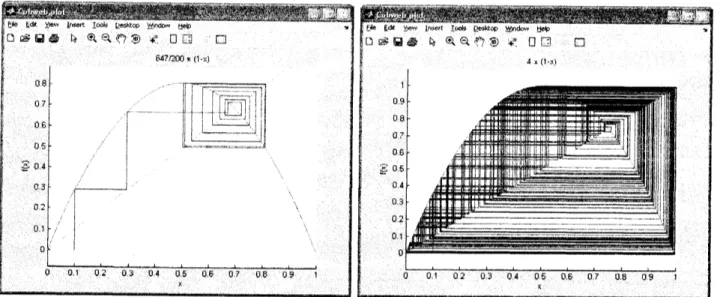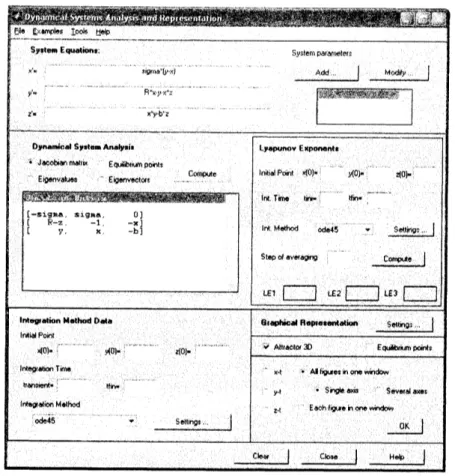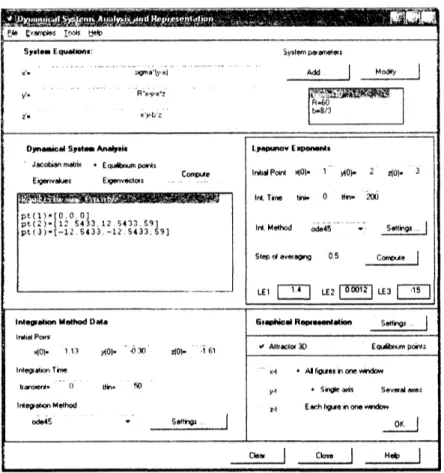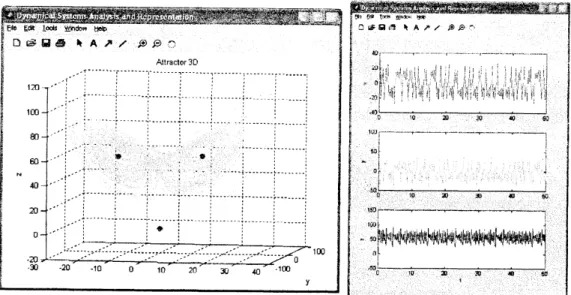A Matlab
Problem-Solving
Environment
for
Nonlinear
Systems
Education
in
Mathematics,
Physics and
Engineering
Akemi
G\’alvez
Tomida
Department
of
Applied
Mathematics
and
Comp.
Sciences
University
of
Cantabria,
Avda.
de
los
Castros
s/n,
E-39005, Santander,
Spain
galveza@unican.es
Abstract
Currently, European countriesareintheprocess of rethinking their Higher
Edu-cation systems due toharmonizationeffortsinitiated by Bologna’sdeclaration. This
scenarioof reformsdemandsacompletelynewapproach to the instructionalprocess.
A major issue in this context is the development of better, updated educational
tools and materials specially adapted to the topics under study. This work reflects
author’sexperiencein developingaproblem-solving environment designed forafirst
course on nonlinear systems for undergraduate students of Mathematics, Physics
andEngineering. In this paperthe architectureofthis computer system along with
a description of its main functionalities are briefly reported.
1
Introduction
Bologna’s
declaration
-seen
today as the well-known synonym for the whole processof
reformation
in thearea
of higher education-was signed in 1999 by 29 Europeancountries with the objective to create “a European space
for
higher education in orderto enhance the employability and mobility
of
citizens and to increase the intemationalcompetitiveness
of
European higher education” [1]. Its upmost goal is the commitmentfreely taken by each signatory country to reform its own higher education system in
order to create overall
convergence
at European level. This process encompasses theadoption of
a
common
framework
of readable and comparable degreesas
wellas
theintroduction of undergraduate and postgraduate levels in all countries along with
ECTS
(European Credit Transfer System) credit systems to
ensure
a
smooth transition fromone
country’s system to another one, thus enforcing free mobility of students, teachersand
administrators among
the European countries.Unquestionably, Bologna’s declaration opened the door to
a
completelynew
scenariofor higher education in Europe. Nowadays, the European countries
are
in the midst ofthe process ofrestructuring theirhigher education system in order to fulfill the objectives
such
as
the definition of thenew
curricula and grading systeins. However, the upcomingchanges go far beyond these structural changes, as the personal development of students and teachers is also at the root of this
new
concept ofeducation. For instance, studentsin this
new
modelare no
longer passive actors of the learning process.On
the contrary,Bologna’s declaration emphasizes the concept ofself-learning
so
that studentsare
gettingmore and more involved in their
own
learning.An important issue in this process is to provide students with
a
good collection of scholar materials that enable them to accomplish the learning process by themselves.During the last few years, the author has been involved in the development ofcomputer
softwarefor
a
firstcourse on
nonlinear systems for undergraduate students ofMathemat-ics, Physics and Engineering. As
a
result,a
new
Matlab problem-solving environmentdesigned to attain the demands of this
new
situation has been created from scratch. Inthis paper the architecture of this computer system along with
a
description of its mainfunctionalities
are
briefly reported.2
Nonlinear
(Chaotic)
Systems
The analysis of chaotic dynamical systems is
one
of the most challenging tasks inCom-putational Science. Because the chaotic systems
are
essentially nonlinear, their behavioris much
more
complicated than that of linear systems. In fact, even the simplest chaoticsystems exhibit
a
bulk of different behaviors thatcan
only be $f\iota illy$ analyzed with thehelp of powerful hardware and software
resources.
The range of different phenomena associated with the nonlinear systems is extremely
varied. Chaos
can
be found in almost any field, ranging from chemical reactions toelec-tronic circuits and lasers [2, 11], meteorology [16], ecology [18], etc. Nonlinearity appears
in both discrete and continuous systems, which are described by iterated functions and
differential
equations, respectively [15, 19]. Thatmeans
that the accurate analysis ofsuch chaotic systems requires specialized mathematical tools and techniques, designed
to account for the kind of system involved. This challenging issue has motivated
an
in-tensive development of
programs
and packages aimed at analyzing therange
ofdifferentphenomena associated with the chaotic systems.
Among these programs and packages, thosebased
on
computer algebra systems (CAS)are receiving increasing attention during the last few years. Recent examples can be
found, for instance, in [3, 4, 5, 6, 8] for Matlab, in [7, 9, 10, 12, 13, 14, 21] for Mathematica and in [22] for Maple, to mention just a few examples. In addition to their outstanding
symbolic features, the CAS also include optimized numerical routines, nice graphical
capabilities and- in a few
cases
suchas
in Matlab- the possibility to generate appealingGUIs (Graphical User Interfaces).
In this paper,
we
describe a problem-solving environment for the analysis of chaoticdynamical systems. The program,
an
improvement of the system reported in [5, 6] andimplemented in the popular
CAS
Matlab, is suitable for both discrete and continuouschaotic systems. To this purpose, specialized symbolic and numerical libraries have been developed. Further, to provide end-users with
a
nice navigation and intuitiveaccess
tothe main methods and routines,
a
powerful graphicaluser
interface (also described inthis paper) has been implemented. To show the good performance of this proposal,
some
Figure 1: Architecture ofthe system.
3
Program
Architecture
and Implementation
3.1
Program
Architecture
Figure 1 shows the architecture of the program described in this paper. It consists of two
1.
a
$nume^{J}r^{v}ical$-symbolic layer it is basicallya
collection of numerical and symboliclibraries containing the commands, functions and routines implemented to perform
numerical and symbolic tasks.
2. agraphicaluser
interface
$(GUI)$ layer. this componentis responsibleforinput/outputwindowing, display of graphical output and smooth interaction with the
user.
3.1.1 Numerical-symbolic layer
The nuinerical-symbolic layer is comprised of three different modules, according to the
distinct processes (numerical, symbolic and graphical) to be carried out:
1.
a
setof
numericd librames containing the implementation of the commands, func-tions and routines for thenumerical
tasks.
They have been implemented in thenative Matlab programming language. To this aim
we
take advantage of the largecollection ofnumerical routines available in the Matlab kernel such libraries
are
con-nected with. These standard Matlabroutines provide extensive control
on
different options andare
fully optimized to offer the highest level of performance.2.
a
setof
symbolic routines andfunctions.
They have been implemented by using theSymbolic Math Toolbox that provides
access
to several Maple routines for symbolictasks. This symbolic module is
more
important than it mightseem
at first sight;for instance, system equations
are
inputted symbolically so thatsome
functional operators (suchas
derivatives)can
be effectively applied. Further, some additionaloperators (string manipulation, forward/backward symbolic object-string
conver-sion, symbol replacement and assigmnent, etc.) have
also
been used for symbolicpurposes. It is worthwhile to mention that the Symbolic Math Toolboxis less
pow-erful than the Maple kemel system it comes from. Fortunately, it is also possible
to connect the kemels of Matlab and Maple for very specialized symbolic tasks.
3.
some
graphical commands. The powerful Matlabgraphical capabilities exceed thosecomunonly available in other
CAS
suchas
Mathematica and Maple. Althoughour
current needs do not require applying them at full extent, they avoid the
users
thetedious and time-consuming task to implement many routines for graphical output
by themselves. Some nice viewing features such as $3D$ rotation, zooming in and
out, labeling, scaling, coloring and others are also automatically inheritedfrom the
Matlab graphical and windowing systems.
3.1.2 Graphical
user
interface layerAlthough the librariesin previous layer
are
oftenenough to meetour
computational needs,end-users might be challenged for using them properly unless they
are
really proficienton
both Matlab syntax and functionalities andour
implemented routines. Thislimita-tion
can
beovercome
by creating a GUI;a
well-designed GUIuses
readily recognizablevisual
cues
to help theuser
navigate efficiently through information. Matlab provides apowerful mechanism to generate GUIs by using the so-called guide $(GUI$ Development
Ehvironment). This feature is not commonly available in many other CAS
so
far.it allows end-users to deal with
our
libraries with a minimal knowledge and input, thusfacilitating
itsefficient
use
anddissemination.
Based
on
this discussion,a GUI
layer has been implemented.Some
examples oftypical windows of
our GUI
are depicted in upper part of Figure 1. Some windowsare
for user interaction-typicalIy input acquisition, parameter tuning and option selection
tasks. Others are windows to display graphical output. All them allow an effective
use
of powerful interface tools designed according to the type of entities being displayed(e.g., drop-down
menu
for a choice list, check buttons for Boolean options, text boxesfor displayingmessages, dialog boxes for input/output
user
interaction, etc.).Additional
functionalities are
providedinhiddenmenus
or
inseparate windows whichcan
beinvokedat will ifneeded
so as
to keep the main windowstreamlinedand uncluttered. Forinstance,all graphical output is displayed in separate windows
so
that theinformation
is betterorganized and flows in
a
natural and intuitive way. Asa
result, the system presentsa
GUI that
isboth
aesthetic and veryfunctional
to theuser.
3.2
Implementation
issues
Regarding theimplementation, thuis program has been developed by the author in Matlab
$v2007b[17]$ running
on Windows
XP operating system by usinga PC
with IntelCore
2 Duo processor at 2.4
GHz.
and2 GB
ofRAM.
However, the program supports manydifferent
platforms, suchas
PCs (with Windows $9x$, 2000, NT, Me, XP and Vista) andUNIX workstations. A version for Apple Macintosh with Mac OS X system is also
available provided that
Mac
Xll (the implementation of the X Window System thatmakes it possible to
run
Xll-based applications in MacOS
X) is properly installed andconfigured. Figures in this paper correspond to the
PC
platform version.The graphical tasks are performed by using the Matlab GUI for the higher-level
func-$tion\llcorner s$ (windowing, menus,
or
input) while the built-in graphics Matlab commands
are
applied for rendering purposes. The numerical kernel has been implemented in the
na-tive Matlab programming language, and the symbolic kernel has been created by using
the commands ofthe Symbolic Math Toolbox.
4
Discrete
Systems
The program
described
in previous section is well suited for dealing with both discreteand continuous dynammical systems. This section illustrates the
use
of this software forthe
case
ofdiscrete
systems.4.1
Fixed points and stability
Given
an
iterated map defined bya
function $f(x)$, afixed
point $x^{*}$ of$f(x)$ is a point thatismapped to itself by thefunction, $i.e$. $f(x^{*})=x^{*}$. Let’s considerfor example thelogistic
map given by $x_{n+1}=\lambda x_{n}(1-x_{n})$, where $n\in$ IN and $\lambda$ is
a
system parameter, usuallytaking values
on
the interval [0,4]. The logistic map became popular followinga
seminalpaper by the biologist Robert May in 1976 [18], where he introduced the discrete version
of
a
demographic model due to Verhulst. Roughly, $x_{n}\in[0,1]$ represents the populationa $arrow$
ffi $\zeta xmbs$ $Io*$ $M$
Systr Equim
$x(n\cdot 1)$.
$|mt,dQ^{\cdot}Y(n).t\uparrow Y(\cap))$ $Pu 6tcr$
Dynmcd$Sy\#-$Andvsis $\llcorner Y\sim unov\in xp\alpha*$ $\Re..bllityotFlx\cdot dPo1mF|xedP\alpha|s.$
. $\theta*\iota_{V}$
.
$|\overline{\underline{Co\mathfrak{m}pu!\epsilon}}|\wedge$ $p_{Qn’\alpha r}lrdPr$$x(0)\Rightarrow$
lxdPc$l1$) $\approx 0$ $\vee \mathfrak{n}$
.
$\vee lh$.
$b\cdot(l\cdot\cdot bd\cdot)$ $\sim 1$ $–\triangleright$ St $b1$.
$lmbd$
.
$-l$ $or$ $1\cdot*bd\cdot\cdot l$ $–\triangleright S\cdot ddl$.
$\infty\alpha\backslash$$b\cdot\prime l\cdot\cdot bd\cdot)$ $\triangleright\downarrow--\succ Un*t\cdot b1$
.
$l\cdot\wedge bd\cdot\cdot$$0$ $-\succ$ $S\backslash lp\cdot r*CUlo$
..$c\alpha_{W}\alpha m$ $-$ $PxdPt(Z)$ $\cdot t1\cdot*bd\cdot-1)/1\cdot\cdot bd$
.
$WP\alpha t$ $x(0)$
.
$b*(\tilde{-}*1\cdot\cdot bd*\}$ 4 1 $–>$ St$*b1$
.
$1\cdot lbd$
.
.
1 or lmbda.
3 $–$, Saddle I$b\cdot t-Z+1\cdot*bd\cdot)$ $\succ 1--\geq un\mathfrak{s}C$ab$l\circ$
$1\cdot-bd$
.
.
$Z–\backslash$ Supa$r$ $*1$.
$p\sim’\alpha ervdr$.
$a\dagger^{-}uc\circ 0\alpha\vee-$ $rwPo t$ $x(0)$
.
$p_{rdn\alpha*r}$ $vn$.
$\vee fh$.
$|\overline{\alpha \text{く}}|$ $xh$.
$x\prime \mathfrak{n}=$ $|\overline{(\supset\ltimes}|$ $\#rSp\kappa oCrW$ $\square 1D$ ロ 20 $\square 3D$ $i\urcorner 1-Po t$ $x(0)$.
$P\alpha’\alpha uw\iota r$.
$\overline{\infty\alpha \text{く}}|$ $\overline{\infty c\infty}|||\overline{ckoe}||\overline{\}sr}|$Figure 2: Fixed points and stability of the logistic map.
system evolves among
a
number of different situations, from the population eventuallydying to stabilizing
or
changing chaoticaly (see [18] formore
details).The program described in
this
papercan
compute the fixed points of any iterated map. To do so,we
must enter the system equationas
shown in Figure 2. Note thatthe equation is given in a mathematical-looking way so that it can be subsequently processed for further symbolic-numerical calculations. For instance, we can also analyze
the stability of fixed points, by computing the eigenvalue of the fixed point, given by:
$\phi=[\frac{df(x)}{dx}]_{x=x^{*}}$ The fixed point is stable if $|\phi|<1$, neutral if $|\phi|=1$, unstable if
$|\phi|>1$, and superstable if $|\phi|=0$. The fixed points for the logistic map
are:
$x=0$ and$\lambda-1$
$x=\overline{\lambda}$. Figure 2 shows the fixed points ofthe logistic map along with their stability
analysis in terms of the $\lambda$ parameter.
4.2
Bifurcation diagrams
Depending on the $\lambda$ value, the logistic map evolves among a number of different
Figure 3:
Bifurcation
diagramof the logistic mapon:
(left) interval $[0,4]$; (right) interval[3.82, 3.86].
Figure 4:
Bifurcation
diagram of the cubic mapon
the interval [1, 4] for the initial conditions: (left) $x_{0}=0.5$; (right) $x_{0}=-0.5$.the possible long-term values (fixed points
or
periodic orbits) ofa
systemas a
functionof a
system parameter. Figure 3 (left) shows thebifurcation
diagram of the logistic mapfor $\lambda\in[0,4]$
.
The initial input consists of the initial point $x_{0}$ and the initial and finalvalues of the system parameter. The bifurcation diagram is
a
fractal: if youzoom
inon
the value $\lambda=3.825$ and focus
on one
branch of the diagram, the situation nearby lookslike
a
shrunk and slightly distorted version of the whole diagram,as
shown in Figure 3 (right). This isan
example of the deep and ubiquitous connection between chaos andfractals.
Figure 5: (left) Lyapunov exponent of the logistic map on the interval $[0,4]$; (right) close
up
on
the interval [3.2, 4].depend on the initial values of the system variable, $x_{0}$. This happens, for instance, for
the cubic map, given by: $x_{n+1}=(1-\mu)x_{n}+\mu x_{n}^{3}$. This system has two fixed points of
the form $x_{1,2}=\pm\sqrt{\frac{\mu-1}{3\mu}}$, meaning that there is
no
single value to display the wholebifurcation diagram. Figure 4 displays the two bifurcation diagrams associated with
this map, obtained from two different initial conditions for the system variable, namely
$x_{0}=0.5$ (left) and $x_{0}=-0.5$ (right). As the reader
can
see, thereare
two missingbranches of the period-4 orbits in each diagram, so both pictures
are
complementaryeach other.
4.3
Lyapunov exponents
One indication of chaoticity is the so-called sensitivity to initial conditions, meaning
that two initially closed arbitrary trajectories diverge exponentially over the time. The
Lyapunov exponent (LE) of a dynamical system is the number that characterizes the
rate of separation of these infinitesimaJly close trajectories along a given direction. Of
course, the rate ofseparation
can
be different fordifferent orientations of initial separationvector, leading to
as
many Lyapunov exponentsas
thenumber of dimensions of the phasespace. LEs
are
intensively applied to analyze the behavior of nonlinear systems, sincethey indicate ifsmall displacementsoftrajectories
are
alongstable or unstable directions.In short,
a
negative LE isan
indicator of regular (stable) behavior while a positive LEmeans
that the orbit is unstable and chaotic.Our program allows
us
to compute the Lyapunov exponents in a very easy way; theinitial input is given by the initial point for the system variable and the interval for the
system parameter. Figure 5 (left) depictes the Lyapunov exponent of the logistic map
for the system parameter on the interval $[0,4]$. Comparison of this picture with Figure 3
(left) shows that negative values for the LE
are
an
indication of regular behavior, whileFigure 6: Cobweb plot of the logistic map: (left) $\lambda=3.235;$ (right)$\lambda=4$
.
for $\lambda=2$, meaning the existence of a superstable fixed point. Figure 5 (right) shows
a
magnification of the figureon
the left for the interval [3.2, 4]. Wecan see
that theLE is positive for $\lambda>3.569\ldots$ except by the existence of
some
periodic windows, thusexplaining very well the bifurcation diagram in Figure 3 (left).
4.4
Cobweb
plot
A
cobweb plot isa
graphical procedure especially suited to analyze the qualitative be-haviourofone-dimensional
iterated fumctions. Cobwebplotsare
usefulbecause theyallowto determine the long-term evolution of
an
initial condition under repeated applicationof
a
map. Figure 6 shows two cobweb plotsfor the logistic map and the initial conditions$\lambda=3.235$ (left), and $\lambda=4$ (right). The first
one
shows thecase
of a period-2 orbit(represented by
a
rectangle) while the secondcase
is a chaotic orbit.4.5
Phase
space
graph
A
very
powerful strategy to analyze chaotic systems is touse
the so-called phase spacegraph By this
we
mean
a collection of pictures associated with the orbit ofa
given point$x_{0}$ and embedded into
different n-dimensional
spaces. For $n=1$ we get the signal oftheorbit, i.e. the sequence of iterates $\{x_{n}\}_{n}$
over
the time. Such sequence is usually calledthe time
serees.
For $n=2$ the graph is obtained by representing the sequence ofiterates$\{x_{n+1}\}$ vs. $\{x_{n}\}$, for $n=3$,
we
represent the sequence of iterates $\{x_{n+2}\}$ vs.$\{x_{n+1}\}$ and
$\{x_{n}\}$ and
so
on.
Figure
7 uses
the phase space graph to analyze the chaotic behavior of the logisticmapfor$\lambda=4$
.
Thesepictures illustrateperfectly how thechaotic behavior lookslike. On
theleft, the signal of the orbit is displayed. As discussed above, a characteristic of chaos
is that chaotic systems exhibit a great sensitivity to initial conditions. A
common source
of such sensitivity to initial conditions is that the map represents
a
repeated folding andFigure 7: (left to right) lD, $2D$ and $3D$ phase space graph for the logistic map.
logistic map, represented in Fig. 7 (middle), gives
a
two-dimensional phase diagram ofthe logistic map showing the quadratic
curve
ofits iterated equation. Wecan
also embedthe
same
sequence ina
$3D$ phasespace,
in order to investigatea
deeper structure of themap. Figure 7 (right) shows how initially nearby points begin to diverge, particularly in
those regions corresponding to the steeper sections of the plot.
5
Continuous Systems
In this section
we
showsome
applications of the program through illustrative examplesforthe
case
ofcontinuous systems. In thuis workwe
restrict ourselves to thecase
offinite-dimensionalflows, whuich
are
mathematically describedby systems of ordinary differentialequations.
5.1
Symbolic-numerical
analysis
Figures
8-11
show screenshots ofa
typical session for analyzing $3D$ continuous systems.The session workflowis
as
follows: firstly, theuser
inputs the system equations expressedsymbolically. For instance, in Figure 8
we
consider thefamous Lorenz system [16], givenby: $(x’, y’, z’)=(\sigma(y-x), (R-z)x-y, xy- bz)$ where $\sigma,$ $R$ and $b$ are the system
parameters. The program includes a module for the computation ofthe Jacobianmatrix and the equilibrium points of any finite-dimensional flow. The Jacobian matrix is
a
square matrix whose entries
are
the partial derivatives of the system equations withrespect to the system variables. If no value for the system parameters is provided, the
computation is performed symbolically and the corresponding output depends
on
thosesystem parameters. The equilibrium points and the eigenvalues and eigenvectors of the
system
can
also be computed ina
similar way.Figure 8 shows the symbolic Jacobian matrix for the Lorenz system, which depends
not only
on
thesystem parameters butalsoon
thesystemvariables. Oncesome
parametervalues
are
given ($\sigma=10,$ $R=60$ and $b=8/3$ in this example), the Lyapunov exponents(LE) ofthesystem
can
be numerically computed. To thispurpose, anumerical integrationmethod is applied [20]. The corresponding options and parameter values are shown in
Figure 9. The numerical values of these LE
are
1.4,0.0012 and-15 respectively. TheirFigure 8: Symbolic Jacobian matrix for the Lorenz system.
Roughly speaking, LEs
are
a generalization of the eigenvalues for nonlinear flows. Inparticular, a negative LE indicates that the trajectory evolves along the stable direction
forthis variable (and hence, regularbehaviorfor that variable isobtained) whileapositive value indicates
a
chaotic behavior.5.2
Visualization
of
chaotic attractors
Since
in our examplewe find
positive LE, the system exhibits a chaotic behavior. Thisfactisevidencedin Figure 11 (left) where the corresponding attractor and the equilibrium
pointsof the Lorenz system for
our
choice of thesystem parametersare
displayed. Their corresponding numerical valuesare
shownin the mainwindowof
Figure9. Finally, Figure11 (right) shows the evolution ofthe system variables
over
the time from $t=0$to $t=50$.
In order to display the attractor and/or the evolution ofthe system variables
over
thetime (like in Figure 11),
some
kind of numerical integration is required. The program in this paper allows end-users tochoosedifferent numerical integration methods [20],includ-ing the
classical
Euler and 2nd- and $4th$-order Runge-Kutta methods (implemented bythe author) along with
some more
sophisticated methods from the Matlab kemel suchas
ode45, ode23, ode113, ode$15s$, ode$23s$, ode$23t$ and ode$23tb$ (see [17] for details).
Some
input required for the numerical integration (such
as
the initial point and the integrationtime) is also given at this stage. By pressingthe “NumericalIntegrationsettings” button,
Ek $E\cross wvusI’*$ $M$
Systm$E\eta udW$
.
-. $x$.
$\Psi^{\mathfrak{n}obx|}$ $\mu$ $R.\nu*x.$. :. $xyb^{\backslash }$ $-\sim-7_{\}$ System wrdr$s$ $1rA9dlrTm$ $ur$.
$0$ $M\sim$ 50 $|n_{C}9dr$Nethod ode45 $su|r9$ $|$$h\star$
.
An$u\cdot\cdot\n$onewndos$y^{1}$
.
$Sr*$am $Se$veielaxes$p|$ $\mathbb{E}aeh1\cdot e\mathfrak{n}$one$1W1\omega$
OK $|$
Cm $|$ $cb,$
.
$|$ $H*$ $|$Figure 9: Equilibrium points and Lyapunov exponents for the Lorenz system.
Figure 10: Temporal evolution of the Lyapunov exponents for the Lorenz system.
maximum stepsize and refinement, the computation speed and others)
can
be set up ina
separate window. Then the
user
proceeds with the graphical representation stage, wherehe$/she$
can
display the attractor ofthe dynamical system and/or the evolution of any ofthe system variables
over
the time. Such variablescan
be depictedon
thesame
or on
different
axes
and windows. The“Graphical Representation settings” button opensa
new
window where different graphicaloptions such
as
the line width and style, markers for theFigure $\ovalbox{\tt\small REJECT}\ovalbox{\tt\small REJECT}\cdot r_{O^{r}C17}lrs)^{r}SCem$
.
$(|_{t^{J}}fC)c\dagger\iota$aot$1C_{Cv}^{\neg}fCractol$. and equilibrium points; (right)tempo-ral $evolutt_{O^{n}}o^{f}s\gamma sCc\tau r\iota var\iota$ablcs.
Figure 12: Chaotic attractors of $3D$ flows: (top-left) Lorenz system; (top-right) R\"ossler
output shown in Figure 11 where the chaotic attractor and the temporal evolution of the
system variables
are
displayed.Figure 12 shows the chaotic attractors of four distinct nonlinear flows: Lorenz system
for
weather forecasting, R\"ossler chemical reaction, Van-der-Pol Duffing oscillator and Chua’s electronic circuit (see [19]for further
informationabout
these systems).Acknowledgments
The author would like to express her sincere acknowledgment and appreciation to Prof.
Setsuo Takato for his kind invitation to participate in this RIMS workshop and visit the
lovely city of Kyoto, and for creating such
a
friendly atmosphere during all my stay inJapan. I really hope we
can
meet again very soon.This research has been supported by the Computer
Science
National Program ofthe Spanish Ministry of Education and Science, Project Ref.
#TIN2006-13615
and theUniversity of Cantabria.
References
[1] The Bologna Declaration
on
the Europeanspace forhigher education:an
explanation.Association ofEuropean
Universities&EU
Rectors’ Conference (1999) pp. 4 (availableat: $http.\cdot//ec.europa.eu/education/policies/educ/bologna/bologna.pdf)$.
[2] Chua, L.O., Komuro, M., Matsumoto, T.: The double-scroll family. IEEE $\mathcal{I}hnsac-$
tions
on
Circuits and Systems, 33, (1986)1073-1118.
[3] Dhooge, A., Govaerts, W., Kuznetsov, Y.A.: Matcont: A Matlab package for
nu-merical
bifurcation
analysis ofODEs.
ACMTransactions on
Mathematical Software,29(2) (2003)
141-164
[4] Dhooge, A., Govaerts, W., Kuznetsov, Y.A.: Numerical continuation of fold
bifurca-tions of limit cycles in MATCONT. Lecture Notes in Computer Science, 2657 (2003)
701-710
[5]
G\’alvez, A.:
Numerical-symbolic Matlab programfor the analysisof three-dimensionalchaotic systems. Lectures Notes in Computer Science, 4488 (2007) 211-218
[6] G\’aJvez, A.: Matlab toolbox and GUI for analyzing one-dimensional chaotic maps.
Intemational
Conference
on Computational Science and Applications, ICCSA2008,IEEE Computer Society Press, Los Alamitos, CA, (2008)
211-218.
[7] G\’aJvez, A., Iglesias, A.: Symbolic/numeric analysis of chaotic synchronization with
a
CAS.
Future Genemtion Computer Systems 25(5) (2007) 727-733[8] Govaerts, W., Sautois, B.: Phase response curves, delays and synchronization in
Matlab. Lectures Notes in Computer Science, 3992 (2006) 391-398
[9] Guti\’errez, J.M., Iglesias, A., Gu\’emez, J., Mat\’ias, M.A.: Suppression ofchaos through
changes in the system variables through Poincar\’e and Lorenz return maps.
[10]
Guti\’errez,
J.M., Iglesias, A.: AMathematica
package for theanalysis and control of chaos in nonlinear systems. Computers in Physics, 12(6) (1998) 608-619[11] Iglesias, A.: A
new
scheme based on semiconductor lasers with phase-conjugatefeedback for cryptographic communications. Lectures Notes in Computer Science,
2510
(2002)135-144
[12] Iglesias, A.,
G\’alvez,
A.: Analyzing the synchronizationofchaotic dynamical systemswith
Mathematica: Part
I.Lectures
Notes in ComputerScience, 3482 (2005)472-481
[13] Iglesias, A., Ga’lvez, A.: Analyzingthe synchronizationofchaoticdynamical systems
withMathematica: Part II. Lectures Notes in Computer Science, 3482 (2005)
482-491
[14] Iglesias, A.,
G\’alvez,
A.: Revisitingsome
control schemes forchaotic
synchronizationwith Mathematica. Lectures Notes in Computer Science, 3516 (2005) 651-658
[15] Lauwerier, H.A.:
One-dimensional
iterative maps. In: Chaos. Holden, A.V. (ed.).Manchester
University Press,Manchester
(1986)[16] Lorenz, E.N.,
Deterministic
nonperiodic flow, Joumalof
Atmospheric Sciences, 20(1963)
130-141.
[17] The Mathworks Inc: Using Matlab. Natick, MA (1999)
[18] May, R.M.: Simple mathematical models with
very
complicated dynamics. Nature261 (1976)
459-467
[19] Ott, E.: Chaos in Dynamical Systems. Cambridge University Press, Cambridge
(1993)
[20] Press, W.H., Teukolsky, S.A., Vetterling, W.T., Flannery, B.P.: Numerical Recipes
(2nd edition),
Cambridge
University Press, Cambridge, 1992.[21] Sarafian, H.: A closed form solution of the run-time of
a
sliding bead alonga
freelyhanging slinky.
Lecture
Notes in Computer Science, 3039 (2004)319-326
[22] Zhou, W., Jeffrey, D.J. Reid,
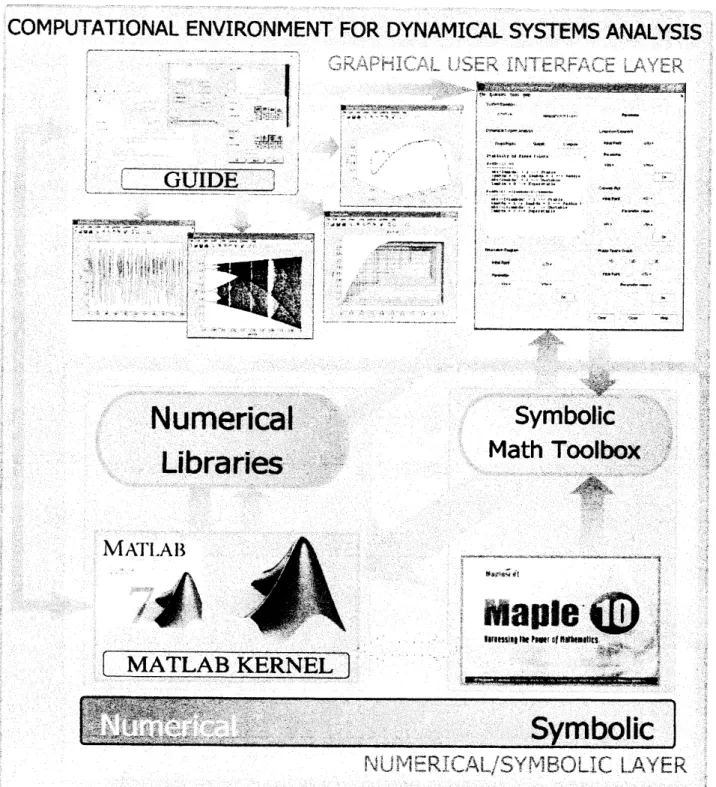

![Figure 4: Bifurcation diagram of the cubic map on the interval [1, 4] for the initial conditions: (left) $x_{0}=0.5$ ; (right) $x_{0}=-0.5$ .](https://thumb-ap.123doks.com/thumbv2/123deta/5989784.1060725/7.892.75.784.529.822/figure-bifurcation-diagram-cubic-interval-initial-conditions-right.webp)
